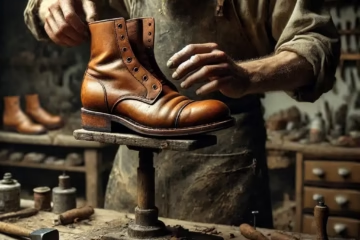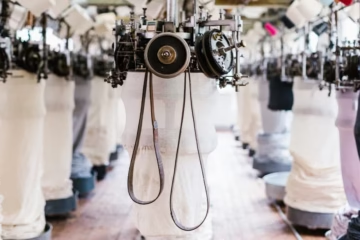Leather Tannery and different tanning methods
Published by Tom on
Have you ever wondered about the means that go into creating the leather for your shoes? In order to produce leather, the process includes a few stages, from drying and curing to tanning and dyeing. We’ll take a closer look at the tanning process and find precisely why the sort of tanning done on the hide impacts the overall outcome of the finished product to a great extent.
What is a Tannery?
A tannery, simply put, is where all your leather is tanned and processed for production. There are several tanneries where shoemakers get their products. The most important word to remember about tanneries is tanning – processing of the raw leather product.
When did tanning start?
Tanning is essential for leather supposing that the rawhide isn’t tanned; it will decay and rot. The tanning process balances out the rawhide or skin protein, preventing rotting and setting it up for a wide assortment of end industrial applications.
The primary distinction among tanned and untanned dry hides is that untanned hides will rot if they get wet, while tanned leather won’t. Tanning likewise changes the overall appearance and composition of the hide. The change relies upon how long it takes to be tanned and the tanning agents that are utilized.
How is leather made?
Leather can be produced using the hide of practically any animal, including pigs, sheep, goats, and crocodiles. Nonetheless, the most well-known hide utilized is from a cow. As a result of the meat and dairy enterprises, making leather uses hides that would somehow be discarded. Or maybe, by making leather, the creature’s cover-up is transformed into an excellent and helpful material that will keep going for a considerable length of time.
The cow’s growth environment will influence the nature of the hide delivered with a decent hide giving an 80-90% yield. For example, dairy animals that have been branded, been exposed to many insect bites, kept close to security barriers, or have had any form of low-quality life can damage their hide. Here you’ll see that the hide yield is bound to be around 60% to avoid flaws and gaps. Indeed, even specific growth enhancement plans incorporating grains or artificial growth hormones can make for a more low-quality hide.
When a hide is readied, the skin is taken out of the animal. Afterward, the flesh should be removed, which should be possible by hand or by utilizing a fleshing machine. If you are doing it by hand, it’s significant that the process must be done as fast as possible, as the material can, without much of a stretch, dry out. Toward the end of the process, you ought to be left with a white, clean surface.
Now the hide ought to be salted or put in a salt brine. This should be a liberal layer of salt as the salt is the thing that prevents it from deteriorating. Suppose a hide isn’t salted, brined, or frozen inside a couple of hours of being removed. In that case, the process of decomposition can start, and the hide may be rendered useless. In general, the hides will be put away, salted, and folded with the tissue sides contacting and will stay salted until it is fit to be prepared when ready to be immersed in water to eliminate any soil or other contaminants.
If the animal hides have hair on it, at that point, it will require this to be eliminated, which is done by utilizing a chemical compound that contains calcium oxide. This might be known as a lime bath, and the soaking can take one to two days. This process will likewise tenderize and soften the animal hide. If you would prefer not to utilize synthetic compounds, the hair can be removed by hand.
After such a lot of bathing and soaking, the hide will be brimming with moisture, so it will grow to be around 4mm thick and can be grafted into two layers. This is done so that separate pieces of the hide can be utilized for various kinds of leather items.
What are the common type of tanning method used?
Chrome tanning
Chrome tanning is a relatively new strategy for tanning, yet effectively the most prevailing. It includes absorbing the hides in baths containing acidic salts until they are prepared for the subsequent stage, chrome tanning. The bath incorporates chromium tanning agents. The acidity of the bath is diminished until the outside of the hides begins retaining the chromium agents. The wet hides delivered from this process are blue and known as “wet blue hides.”
Chrome tanning is quicker than vegetable tanning and can take as long as a day with present-day apparatus. After the underlying tanning measure, the leather is cut into different thicknesses as required by the leather craftsmen. It is then additionally handled for making leather products. Being an exceptionally mechanized process, this sort of leather is mainstream. It costs not precisely more than labor-intensive tanning methods.
Vegetable tanning
Another technique, vegetable tanning, has been used since ancient times and includes the tannins from the bark and leaves of trees and plants. After the preparation phase, the hides are set in the tanning pit. There are drums containing tanning solutions of different concentrations. Over a few months, the tanners move the hides drum to drum, with the solution getting more concentrated. The tanning agents penetrate the skins. The fermentation and depositions process leaves the hides with a distinct color and appearance.
Synthetic tanning
Synthetic tanning is much of the time utilized as an option to chrome tanning. It isn’t used in isolation, yet it is done in combination with either vegetable tanning or chrome tanning. It utilizes artificial tanning agents, for example, formaldehyde, glutaraldehyde, phenols, and acrylates. The wet and undyed leather has a splendid shading after tanning, which gives it the name wet white. Tanning with aldehydes and oils produce delicate leathers like those utilized in vehicle seats. This framework can be used to deliver dry-cleanable and launderable design leathers just as chamois leather.
Leather tanning has its roots since early human civilization. Leather has been a staple accessory of humans. Thus it is no wonder that today people use it for basic functionality in their daily lives.
Tanning is an essential part of leather manufacturing. Though, it involves several processes to make the leather more desirable and elegant. It is crucial to remember that each function contributes to the overall outcome of the finished product.


